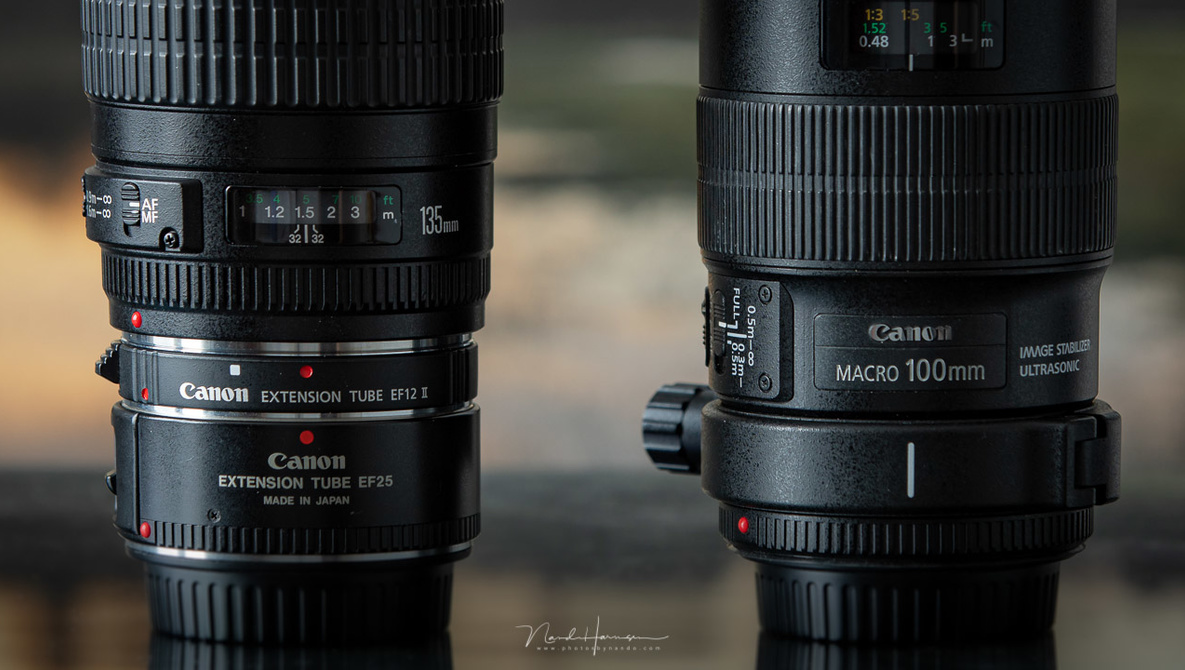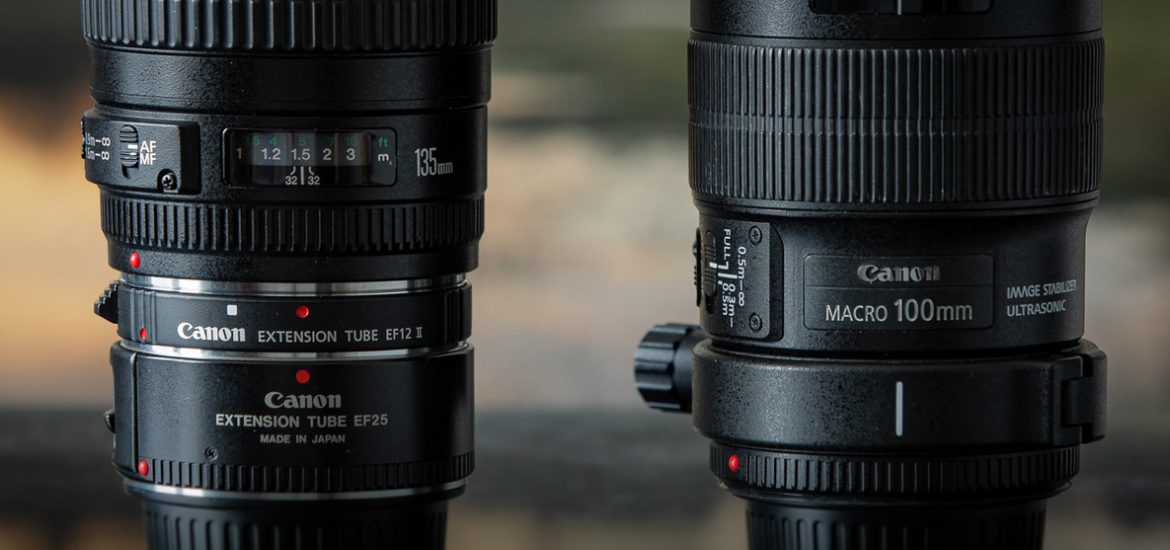
If you want to photograph small things, you need to get close. For that, you can choose a macro lens. But there is an alternative that is much cheaper. Extension tubes transform any lens into a macro lens. But what is the better choice?
A macro lens is a wonderful tool that allows us to capture a subject in a 1:1 magnification. Some macro lenses can magnify even more, but these are very specialized lenses. Most of the time, a 1:1 magnification is more than enough.
Buying a macro lens can be expensive, although there are also relatively cheap macro lenses available. But extension tubes will always be cheaper. These tubes bring a lot of flexibility. You can use an extension tube with every normal lens. These tubes allow you to focus real close with nice magnifications, especially with super tele lenses. That combination is perfect for shooting frogs and other small wildlife that are difficult to approach.
What Are Extension Tubes?
An extension tube is nothing more than a spacer between a lens and camera. The extension tubes are hollow, without any glass. The only thing an extension tube has is the contact points for the communication between camera and lens. If you are in the market for extension tubes, make sure your set has those contact points.
Because the lens will be farther from the sensor, the minimum focal distance will decrease. Because the distance between lens and camera is larger, the image circle will become larger at the sensor plane. That will introduce a larger magnification.
Infinity Is Out of Reach
Because the distance from the lens to the camera is larger, you will lose the ability to focus on infinity. In a sense, the complete focus range is shifted towards you.
Let me give you an example. A Canon EF 135mm f/2L lens has a focus range from 0.9 meters until infinity. If I place a 25mm extension tube between the lens and the camera, this focus range will change from 0.4 meters up to 0.7 meters. I have the ability to get closer to the subject, but I can’t focus on infinity anymore.
Calculate the New Magnification Yourself
The magnification factor of the lens will increase when extension tubes are used. Unfortunately, it is nearly impossible to reach the 1:1 magnification of a real macro lens. If I take the example of the Canon EF 135mm f/2L lens, with a 25mm extension tube the magnification will change from 0.19x to 0.38x.
It is possible to calculate the additional magnification when using extension tubes. Just divide the extension tube length by the focal length of the lens. The outcome is the extra magnification on top of the standard magnification.
Extra magnification = tube length (mm) / focal length (mm)
The Difference With a Macro Lens
Although the differences between extension tubes and a macro lens are obvious, I would like to mention these nevertheless. There are three main differences. The macro lens can focus from a minimum focus distance up to infinity, and with extension tubes, that is not possible. The macro lens can reach up to a magnification of 1:1 or even more. With extension tubes, you can’t.
On the other hand, extension tubes are not expensive. But the biggest benefit is the ability to use extension tubes with every lens you own. As a matter of fact, you can also use these tubes with macro lenses, reaching beyond the 1:1 magnification.
How About Image Quality?
If I would try to compare a macro lens with a lens fitted with extension tubes, I would be comparing the image quality of the lenses themselves rather than the extension tubes. After all, these tubes don’t have extra glass inside that can influence image quality.
I decided to do the test nevertheless by comparing the images between the Canon EF 100mm f/2.8L macro lens and the Canon EF 135mm f/2L lens with stacked Canon EF 12mm and Canon EF 25mm extension tubes. Together, these tubes are 37mm which gives me a 37/135 = 0.27 times extra magnification. In this case, I will reach a 0.46x magnification with this combination.
The reason I chose the EF 135mm f/2L is simple. This lens is famous for its image quality. The focal length may be a bit longer compared to the 100mm of the macro lens, but it doesn’t differ that much. I thought it would be a reasonably fair comparison. I tried to use the same magnification with both the EF 135mm f/2L and the EF 100mm f/2.8L Macro.
For the test, I have photographed a flat surface and aligned the camera and lens to my best ability. I have photographed this flat surface with three different apertures: f/2.8, f/8, and f/22. I used manual focus and focused with live view right in the center of the image.
Because a resized image won’t show much difference, I have enlarged the two areas indicated by the rectangles to have an almost 100% crop. Let’s have a look at the crops with the three different apertures.
Aperture f/2.8
If you compare these images, you see how the middle of the image is nearly the same in quality. There might be some small differences, but you have to look carefully to notice them. In the corner, it is a completely different story. The use of extension tubes on the 135mm lens results in a significantly reduced sharpness. But you can argue this is due to the image quality of the 135mm lens.
Aperture f/8
The sweet spot for many lenses is more or less f/8. At this aperture, the lenses should perform at their best. If you compare the images, you’ll see how the image sharpness in the middle is very good with both lenses.
The corners of both images show a clear increase in sharpness. Although the quality of the macro lens is not reached, the difference of the 135mm with extension tubes compared to f/2.8 is significant.
Aperture f/22
By closing the aperture down to f/22, the images don’t show a better image quality. At this point, diffraction plays an important role, reducing the overall sharpness of both lenses. This has to do with physics and is inevitable.
The reduced image sharpness is most obvious in the center part of the image. In the corners, the reduced sharpness is less obvious. The diffraction seems to be less than the corner sharpness that was present at f/8.
Which Is the Better Choice?
The macro lens will produce a better overall result compared to the 135mm with extension tubes. But you have to be careful with conclusions. The image quality is probably depending on the lens that is used with the extension tubes. An exceptionally good lens with extension tubes may outperform the macro lens. On the other hand, an exceptionally good lens may cost even more than a macro lens. In any way, I believe the macro lens wins the comparison.
And then again, if you are just an occasional macro photographer, or if you don’t have the money to spend on a macro lens, extension tubes are a very good choice. These tubes are small, lightweight, and can be used with almost every lens, even a macro lens.
Do you own extension tubes or do you prefer a macro lens? Perhaps you own both and use these tubes next to a macro lens or together with a macro lens. Please share your thoughts and experiences in the comments below.
